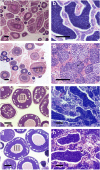Analysis on the Meiosis-Related Gene (Dmc1, Ph1) Expression in Autotriploid Carassius auratus
- PMID: 31520246
- PMCID: PMC6890579
- DOI: 10.1007/s10126-019-09921-x
Analysis on the Meiosis-Related Gene (Dmc1, Ph1) Expression in Autotriploid Carassius auratus
Abstract
Triploid is usually considered to be unable to perform normal meiosis due to the abnormal behavior of the three sets of chromosomes. But autotriploid Carassius auratus in the Dongting water system (3n = 150, abbreviated as 3nCC) can perform normal meiosis. In artificial autotriploid Carassius auratus (3n = 150, abbreviated as 3nRR), female individuals undergo normal meiosis and produce mature gametes, while male individuals cannot. To better understand the effects of triploidization on meiosis in fish, we study the structure, methylation level, and expression level of meiosis-related genes (Dmc1, Ph1) in diploid Carassius auratus (2n = 100, abbreviated as 2nCC), Carassius auratus red var.(2n = 100, abbreviated as RCC), 3nCC and 3nRR. The results show that, compared with their diploid ancestors (2nCC and RCC), Dmc1 and Ph1 genes are hypomethylated in all 3nCC and female 3nRR, while are hypermethylated in male 3nRR. Correspondingly, Dmc1 and Ph1 genes are highly expressed in all 3nCC and female 3nRR, while are lowly expressed in male 3nRR. These results indicate that high expression of meiosis-related genes can contribute to restoration of bivalent pairing during meiosis in autotriploid Carassius auratus. This study provides new insights into the effect of DNA methylation on the fertility in triploid fish.
Keywords: Expression; Meiosis; Meiosis-related gene; Methylation; Triploid.
Conflict of interest statement
The authors declare that they have no competing interests.
Figures






Similar articles
-
Expression and localization of HPG axis-related genes in Carassius auratus with different ploidy.Front Endocrinol (Lausanne). 2024 Feb 12;15:1336679. doi: 10.3389/fendo.2024.1336679. eCollection 2024. Front Endocrinol (Lausanne). 2024. PMID: 38410696 Free PMC article.
-
Formation of autotriploid Carassius auratus and its fertility-related genes analysis.BMC Genomics. 2021 Jun 10;22(1):435. doi: 10.1186/s12864-021-07753-5. BMC Genomics. 2021. PMID: 34107878 Free PMC article.
-
Evolutionary dynamics of 18S and 5S rDNA in autotriploid Carassius auratus.Gene. 2020 May 5;737:144433. doi: 10.1016/j.gene.2020.144433. Epub 2020 Jan 31. Gene. 2020. PMID: 32014563
-
Autotriploid origin of Carassius auratus as revealed by chromosomal locus analysis.Sci China Life Sci. 2016 Jun;59(6):622-6. doi: 10.1007/s11427-016-5040-7. Epub 2016 Apr 15. Sci China Life Sci. 2016. PMID: 27084707
-
Distant hybridization leads to different ploidy fishes.Sci China Life Sci. 2010 Apr;53(4):416-25. doi: 10.1007/s11427-010-0057-9. Epub 2010 May 7. Sci China Life Sci. 2010. PMID: 20596907 Review.
Cited by
-
The alternative transcription and expression characterization of Dmc1 in autotetraploid Carassius auratus.Front Genet. 2023 Mar 28;14:1135006. doi: 10.3389/fgene.2023.1135006. eCollection 2023. Front Genet. 2023. PMID: 37056290 Free PMC article.
-
Comparative transcriptomic analysis of reproductive characteristics of reciprocal hybrid lineages derived from hybridization between Megalobrama amblycephala and Culter alburnus.BMC Genom Data. 2023 Aug 12;24(1):45. doi: 10.1186/s12863-023-01141-6. BMC Genom Data. 2023. PMID: 37573319 Free PMC article.
-
Expression and localization of HPG axis-related genes in Carassius auratus with different ploidy.Front Endocrinol (Lausanne). 2024 Feb 12;15:1336679. doi: 10.3389/fendo.2024.1336679. eCollection 2024. Front Endocrinol (Lausanne). 2024. PMID: 38410696 Free PMC article.
-
Formation of autotriploid Carassius auratus and its fertility-related genes analysis.BMC Genomics. 2021 Jun 10;22(1):435. doi: 10.1186/s12864-021-07753-5. BMC Genomics. 2021. PMID: 34107878 Free PMC article.
References
-
- Bird KA, Vanburen R, Puzey JR, Edger PP. The causes and consequences of subgenome dominance in hybrids and recent polyploids. New Phytol. 2018;220:87–93. - PubMed
-
- Bishop JW, Kim S, Villamil MB, Lee DK, Rayburn AL. Meiotic pairing as an indicator of genome composition in polyploid prairie cordgrass (Spartina pectinata link) Genetica. 2017;145(2):235–240. - PubMed
-
- Boden SA, Langridge P, Spangenberg G, Able JA. TaASY1 promotes homologous chromosome interactions and is affected by deletion of Ph1. Plant J. 2010;57(3):487–497. - PubMed
MeSH terms
Grants and funding
LinkOut - more resources
Full Text Sources
